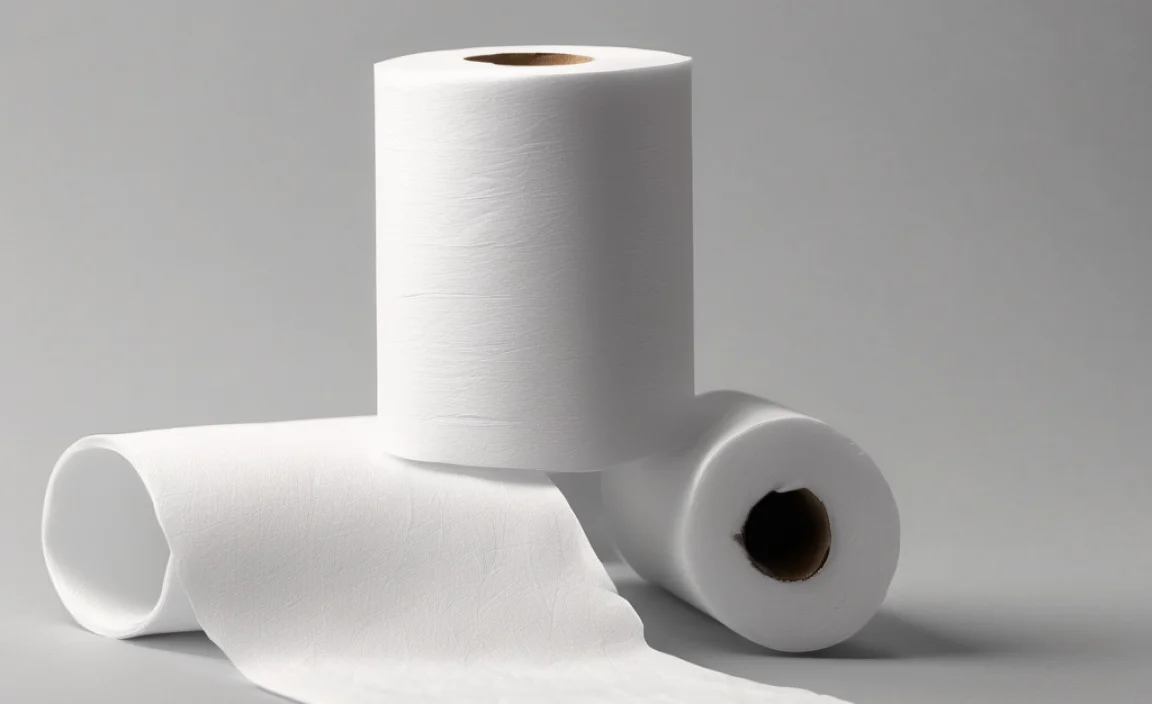Quick Summary: Yes, toilet paper can be affected by port strikes. Port strikes can disrupt the supply chain, causing delays in shipments of raw materials (like wood pulp) and finished products. This can lead to temporary shortages and potentially higher prices for consumers. Monitoring news reports and diversifying your shopping sources can help you stay prepared.
Ever find yourself staring at empty shelves, wondering where your favorite toilet paper disappeared to? Supply chain disruptions can be frustrating, especially when it affects everyday essentials. Port strikes, while necessary for labor negotiations, can throw a wrench into the smooth delivery of goods we rely on.
Don’t worry! This guide will break down how port strikes impact toilet paper availability and what you can do to prepare. We’ll cover everything from understanding the supply chain to practical tips for ensuring you’re not caught short. Let’s get started and keep your bathroom stocked!
Understanding the Toilet Paper Supply Chain

To understand how port strikes affect toilet paper, it’s important to know where toilet paper comes from and how it gets to your local store.
From Forest to Shelf: The Journey of Toilet Paper
The toilet paper supply chain involves several key steps:
- Raw Material Sourcing: Most toilet paper is made from wood pulp, which comes from trees. Some manufacturers use recycled paper.
- Pulp Production: The wood is processed into pulp at paper mills.
- Paper Manufacturing: The pulp is then turned into large rolls of paper.
- Converting: These large rolls are converted into the smaller rolls we recognize as toilet paper. This includes cutting, perforating, and packaging.
- Distribution: The finished product is shipped to warehouses and distribution centers.
- Retail: Finally, the toilet paper is transported to retail stores, where consumers can purchase it.
The Role of Ports in the Supply Chain
Ports are critical transportation hubs in the supply chain. They are where goods are transferred between ships, trains, and trucks.
- Importing Raw Materials: Many toilet paper manufacturers import wood pulp from other countries.
- Exporting Finished Products: Some toilet paper is manufactured in one country and exported to others.
- Handling Large Volumes: Ports handle massive quantities of goods, making them essential for efficient distribution.
How Port Strikes Disrupt the Supply Chain

Port strikes occur when port workers stop working due to labor disputes. These strikes can have a ripple effect throughout the supply chain.
Immediate Effects of a Port Strike
The immediate consequences of a port strike include:
- Delayed Shipments: Ships cannot unload or load cargo, leading to delays.
- Backlogs: Cargo piles up at the ports, creating backlogs that can take weeks or months to clear.
- Increased Costs: Shipping companies may incur extra costs due to delays, which can be passed on to consumers.
Ripple Effects on Toilet Paper Availability
The impact on toilet paper availability can be significant:
- Raw Material Shortages: If wood pulp shipments are delayed, toilet paper manufacturers may face shortages.
- Production Slowdowns: Shortages of raw materials can lead to reduced production or even temporary shutdowns.
- Retail Shortages: As production slows and distribution is disrupted, retail stores may experience shortages of toilet paper.
Historical Examples of Port Strikes and Their Impact

Looking at past port strikes can provide insight into potential impacts.
Case Study 1: 2014-2015 West Coast Port Slowdown
In 2014 and 2015, a labor dispute caused significant slowdowns at West Coast ports in the United States. This resulted in:
- Major Delays: Ships were delayed for weeks, causing significant disruptions to the supply chain.
- Economic Impact: The slowdown cost the U.S. economy billions of dollars.
- Retail Effects: While toilet paper specifically wasn’t highlighted, general consumer goods faced delays and shortages, demonstrating the vulnerability of supply chains.
Case Study 2: 2023 German Port Strikes
In 2023, strikes at German ports also caused considerable disruptions:
- Supply Chain Issues: The strikes led to delays in the movement of goods, affecting various industries.
- Economic Consequences: The German economy felt the strain as exports and imports were hampered.
- Broader European Impact: Disruption spread beyond Germany, affecting supply chains throughout Europe.
Factors That Can Worsen the Impact

Several factors can amplify the impact of a port strike on toilet paper availability.
Just-in-Time Inventory Management
Many retailers use just-in-time (JIT) inventory management. This means they keep minimal stock on hand and rely on frequent deliveries. While efficient, JIT systems are vulnerable to disruptions.
- Low Stock Levels: Stores don’t have large reserves of toilet paper.
- Reliance on Regular Deliveries: Any delay can quickly lead to empty shelves.
- Increased Vulnerability: JIT systems offer little buffer against supply chain disruptions.
Global Events and Demand Surges
Unforeseen events can also exacerbate the impact of port strikes.
- Pandemics: The COVID-19 pandemic led to panic buying and hoarding, creating unprecedented demand for toilet paper.
- Natural Disasters: Events like hurricanes or earthquakes can disrupt transportation and production.
- Unexpected Demand: Sudden increases in demand, driven by social media trends or other factors, can strain the supply chain.
How to Prepare for Potential Toilet Paper Shortages

While you can’t control port strikes, you can take steps to prepare for potential shortages.
Stockpiling Strategies
Consider keeping a reasonable supply of toilet paper on hand.
- Assess Your Needs: Calculate how much toilet paper your household uses in a month.
- Create a Buffer: Aim to have a 1-2 month supply on hand.
- Store Properly: Keep toilet paper in a dry, accessible location.
Diversifying Your Shopping Sources
Don’t rely on a single store or brand.
- Explore Different Retailers: Shop at multiple stores to increase your chances of finding toilet paper.
- Consider Online Options: Online retailers may have different supply chains than brick-and-mortar stores.
- Try Different Brands: Be open to trying different brands of toilet paper.
Alternative Products to Consider
In case of severe shortages, consider alternative products.
- Bidet Attachments: Bidet attachments can reduce your reliance on toilet paper.
- Reusable Cloth Wipes: These can be washed and reused, reducing waste and dependence on paper products.
- Paper Towels: While not ideal for plumbing systems, paper towels can be used in emergencies (dispose of them in the trash, not the toilet).
Monitoring the Situation
Staying informed is key to anticipating and responding to potential shortages.
Tracking Port Activity and Labor Negotiations
Keep an eye on news reports and industry updates.
- Follow News Outlets: Stay informed about port strikes and labor negotiations.
- Check Industry Publications: These publications often provide detailed information about supply chain issues.
- Set Up Alerts: Use Google Alerts or other tools to receive notifications about relevant news.
Using Supply Chain Tracking Tools
Some tools can help you monitor the supply chain in real-time. Although typically used by businesses, understanding their function can highlight the complexity of the system.
- Real-Time Visibility: These tools provide insights into the location and status of goods.
- Early Warning Systems: They can alert you to potential disruptions.
- Data Analysis: Supply chain tracking tools can help you identify vulnerabilities and improve resilience.
The Future of Toilet Paper Supply Chains
The toilet paper supply chain is evolving to become more resilient and efficient.
Technological Innovations in Supply Chain Management
Technology is playing a growing role in supply chain management.
- Blockchain Technology: Blockchain can improve transparency and traceability in the supply chain.
- AI and Machine Learning: These technologies can be used to predict demand and optimize logistics.
- Automation: Automation can improve efficiency and reduce the risk of human error.
Building More Resilient Supply Chains
Companies are taking steps to build more resilient supply chains.
- Diversification: Sourcing materials from multiple suppliers reduces reliance on any single source.
- Regionalization: Manufacturing products closer to consumers can reduce transportation costs and delays.
- Inventory Management: Balancing just-in-time inventory with strategic stockpiling can improve resilience.
Table: Comparing Toilet Paper Alternatives
| Alternative | Pros | Cons | Cost |
|---|---|---|---|
| Bidet Attachment | Reduces toilet paper use, hygienic, environmentally friendly | Requires installation, may require electrical outlet, initial cost | $30 – $200+ |
| Reusable Cloth Wipes | Eco-friendly, cost-effective in the long run, gentle on skin | Requires washing, storage, and a system for handling soiled wipes | $20 – $50 (for a set) |
| Paper Towels | Readily available, disposable | Not flushable, can clog plumbing, not as soft as toilet paper | Varies |
Table: Strategies for Managing Toilet Paper Shortages
| Strategy | Description | Benefits | Drawbacks |
|---|---|---|---|
| Stockpiling | Maintaining a 1-2 month supply of toilet paper | Ensures availability during shortages, reduces stress | Requires storage space, potential for waste if overstocked |
| Diversifying Sources | Shopping at multiple retailers, online and offline | Increases chances of finding toilet paper, reduces reliance on a single source | Requires more time and effort to shop around |
| Using Alternatives | Adopting bidet attachments, cloth wipes, or other alternatives | Reduces dependence on toilet paper, can be more sustainable | May require an initial investment or changes in hygiene habits |
FAQ: Toilet Paper and Port Strikes
1. Can a port strike really affect toilet paper availability?
Yes, absolutely. Port strikes disrupt the supply chain, causing delays in shipments of raw materials and finished products, which can lead to shortages.
2. How long do toilet paper shortages typically last after a port strike?
It varies, but shortages can last from a few weeks to several months, depending on the length and severity of the strike, and how quickly the supply chain can recover.
3. Is it worth stockpiling toilet paper in anticipation of a port strike?
A reasonable supply (1-2 months) is a good idea. Over-stockpiling can lead to unnecessary panic and hoarding, which worsens the situation for everyone.
4. Are some brands of toilet paper more likely to be affected by port strikes than others?
Yes, brands that rely heavily on imported raw materials or are manufactured overseas may be more vulnerable to disruptions caused by port strikes.
5. What are some reliable sources for tracking potential port strikes?
Follow major news outlets, industry-specific publications, and labor union websites for updates on port activity and labor negotiations.
6. Can I use paper towels as a substitute for toilet paper?
In an emergency, yes, but paper towels are not designed to be flushed and can cause severe plumbing problems. Dispose of them in the trash instead.
7. Are bidet attachments easy to install?
Most bidet attachments are relatively easy to install and require basic plumbing knowledge. Many models come with clear instructions and all the necessary hardware.
Conclusion
Port strikes can indeed impact the availability of everyday essentials like toilet paper. By understanding the supply chain, staying informed, and taking proactive steps, you can navigate potential shortages with confidence. Keep a reasonable supply on hand, explore alternative products, and monitor news reports to stay one step ahead. With a little preparation, you can ensure that you’re never caught short, no matter what disruptions the world throws your way. Now you can keep your bathroom stocked and your mind at ease!

